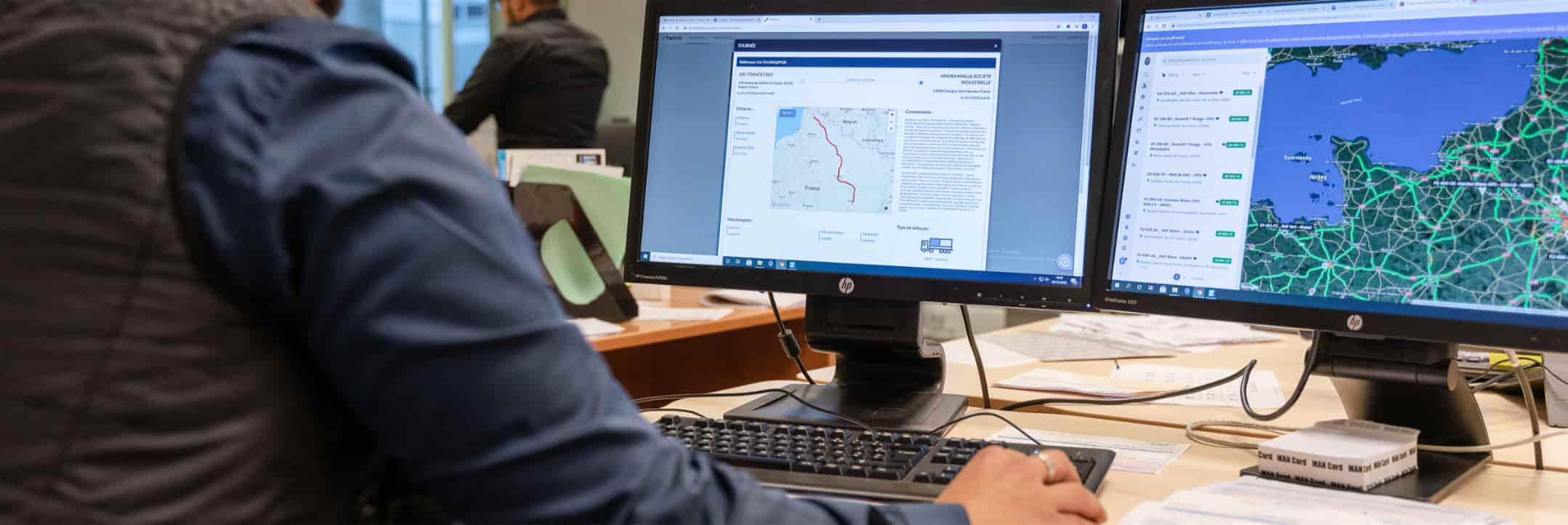The transport
Operating System
Technology working for industry
Fretlink developed the Transport Operating System to optimise the implementation and execution of transport plans. A new standard of collaboration for carriers and shippers alike, it is based on computer modeling of the terrain and operations to make daily life more fluid and clearer.
The Transport Operating System rationalizes the flow and counterflow logic, optimising vehicle loads and distances traveled on a global scale.
All stages of the purchasing and management process are now centralized, allowing standardized collaboration between all stakeholders and controlled management of transport operations.
Rethinking how transport plans are organised
Data collected in the field allows us to create transport plans by proposing trade-offs to find the best balance between cost, capacity and quality of service, all based on existing operational parameters.
Indeed, a lack of capacity or quality of service only leads to additional costs (leading to the spot market, penalties for delays, etc.). However, by outlining an appropriate purchase price, it’s now finally possible to guarantee the quality and capacity required for a given line.
Business targets
Technological levers
Improvement of services
Time savings
Budget control

01Optimisation
We digitalize physical flows via our Transport Operating System to generate a comprehensive overview
As a result, we can investigate the needs of several shippers - and the routes operated by several carriers - from one central location.
Technically, this amounts to making transport plans inter-operable, in order to identify and implement multi-shipper and multi-supplier synergies.
To achieve this, Fretlink synchronizes with existing solutions and software on the market, including TMS, WMS, spot and tender management, visibility, invoicing and document management.
The interoperability of transport plans means we can establish an optimised organisation, which benefits all the stakeholders involved:
- Organisation in relevant flows and counter-flows
- Reducing miles driven
- Better filled vehicles
- Increased profitability for carriers

02Availability
We then make sure we fully understand the needs of our partners, guaranteeing the appeal and profitability of our transport offers.
This helps us continue to offer relevant loads to our partners and guarantee their support for our customers.
Practically, we ask our partners to tell us which areas they operate in and which offers they’d like to hear about.
Knowledge of our partners’ availabilities and needs helps us tailor transport offers that complement their business.
- Visibility of available capacities
- Attractiveness of offers
- Guaranteed catch rate
- Increased margins and sustainability of the carriers’ business

03Quality
Once the transport is taken care of, we do our utmost to deliver a level of service above market standard.
By ensuring on-time deliveries, we value the work done by our partners and guarantee the satisfaction of our customers’ own customers.
To do this, we’ve developed digital tools to help the operational teams in charge of overseeing transport.
The entire chain is covered, from assigning loads to the right carrier, all the way to invoicing, including managing risk, updating ETAs and controlling CMRs. As a result, we’re able to improve the ability of operational staff to act and deliver at every stage of the process.
The digital tools used by our operational teams alongside a high-degree of standardization help us make exchanges and collaboration more fluid, thereby improving the level of service delivered.
- Transparency and information flows
- Task automation: optimising time spent
- Quality improvements and penalty reductions
- Improved decision-making
01Operational coordinators
They set up a communication matrix with each customer, ensuring that specifications are properly carried over.
02Operational staff
They allocate shipments to qualified and available carriers, supervise the execution of the service and notify the parties involved as soon as a problem arises. They guarantee a smooth organisation with no surprises.
03Quality department
Controls the quality and veracity of information at each stage: placing orders, processing CMRs and invoices, pallet returns and managing disputes.
04Shipping and purchasing managers
Our clients receive operational reports and can access their dashboard to monitor their performance.

Carrier
If you want to optimise your business, develop your fleet and your methods, we can help.
Learn more

Shippers
If you want to optimise your transport organisation, our offers can meet your needs.
Learn more

Fretlink
If you are interested in joining our team, the first step is to contact our Human Resources team.
Learn more